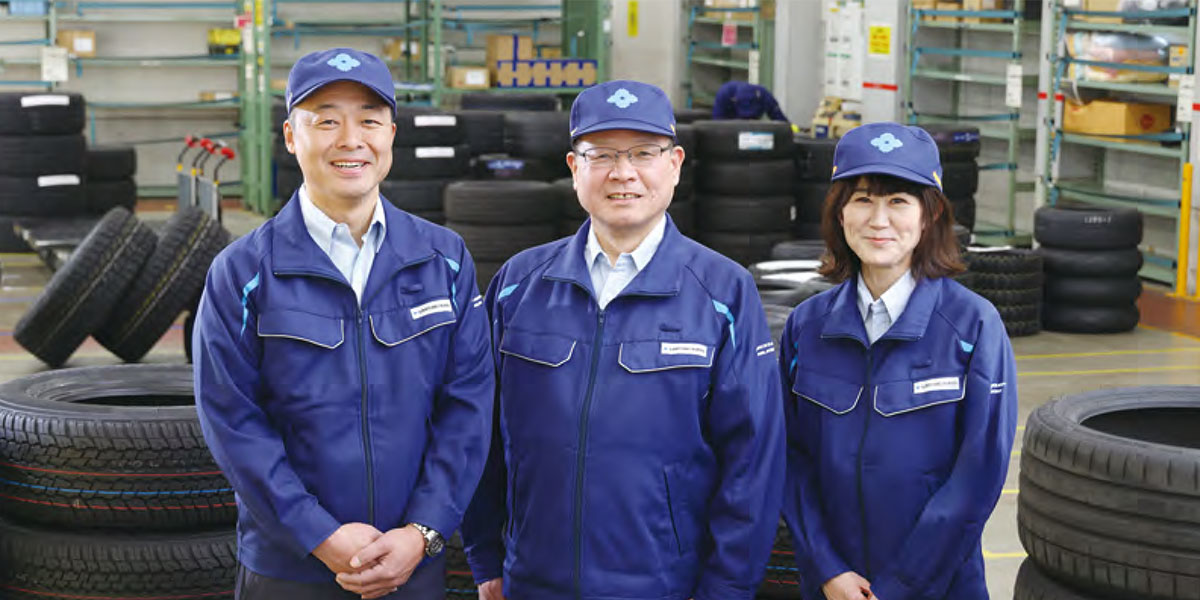
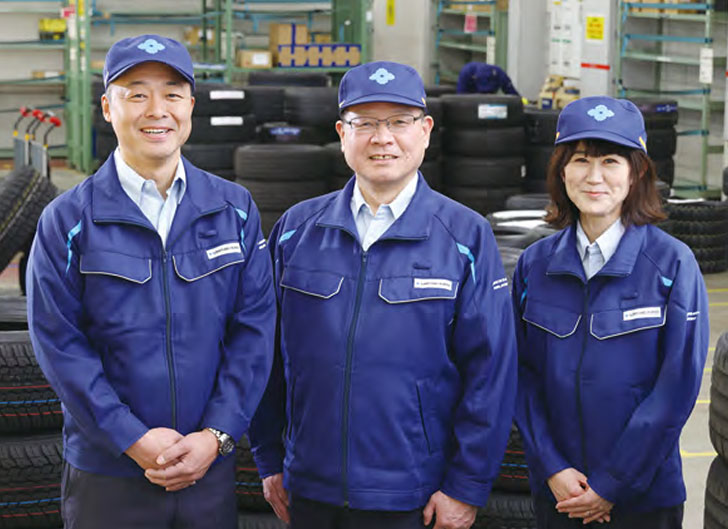
Aiming for a Factory Where Everyone Wants to Work
In July 2024, the Sumitomo Rubber Group launched the “Future Factory Project for Better Workplaces” with factories and the head office working together to solve various issues at manufacturing sites.
Here, three factory workers participating in the project gathered to discuss the issues they face at their manufacturing sites and made recommendations for creating a workplace environment that makes employees want to work there.
Kohara
I am the plant manager of the Miyazaki Factory. In Japan, the percentage of young people working in the manufacturing industry is decreasing year by year, and at our factory, we are also concerned about whether we will be able to secure human resources for manufacturing divisions in the future. Although we have been working to develop multi-skilled workers so that when someone is absent from work, another person can take over, we feel that employees at manufacturing sites are becoming exhausted due to the physically demanding nature of the work and working styles.
Okamoto
I am the assistant manager at the Izumiotsu Factory and oversee the production department. In manufacturing, improving productivity and meeting production targets have always been key indicators, and the number of workers needed is calculated based on past attendance and productivity, so we've had to make do with limited staff. As a result, issues with work styles and the working environment have been put on the back burner. Even though there is a vacation policy in place, it is difficult to take time off. There have been gradual improvements through company initiatives such as the treatment of employees, but there are still many other issues that need to be addressed, such as dealing with the aging of the factory.
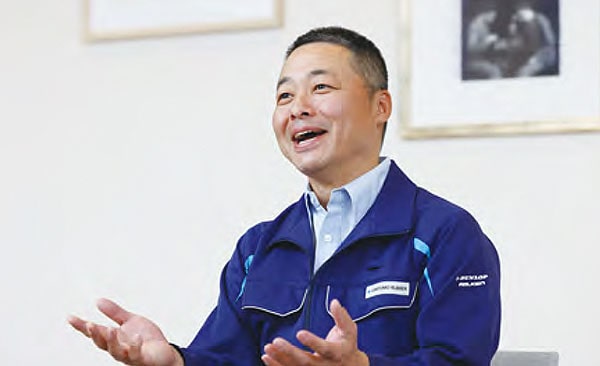
Okuma
I am in charge of the Nagoya Factory Quality Control Section. After joining the Company, I was assigned to the factory’s production technology division and then worked in design at the head office for several years. I am now back at the factory again. During the past 10 years or so, I feel that there has been no progress in the improvement of the work environment at manufacturing sites. Factories are still maledominated and it is difficult for women to demonstrate their capabilities.
Kohara
Addressing issues at factories was up to individuals at each factory, and I felt there was a lot of room for improvement.
Okuma
In response to the situation at the time, the “Team for Increasing the Ratio of Female Operators,” one of the teams in the ROESG Project, and the predecessor of this project, was launched in 2021. As we continued our activities to increase the number of female operators and promote women’s empowerment, we became acutely aware that fundamental improvements to the workplace environment and working styles require an adequate budget. We also realized that company-wide rules must also be reviewed, and that it would be difficult to solve the issues through on-site efforts alone. As a result, with the end of the ROESG project period, our activities developed into this company-wide project.
Okamoto
At the Izumiotsu Factory, we heard about the results of the workplace improvement effort made by Ms. Okuma and her team. I feel that the situation is gradually improving, as factories are now sharing examples of work improvement efforts and upgrading welfare facilities such as restrooms.
Okuma
A women-friendly workplace is a workplace that is friendly to anyone regardless of gender or age. Let me introduce an example. For example, when we lowered the height of work shelves from a female viewpoint, it was also well received by men, who said they were “easy to use.” With this in mind, the starting point of the discussion in the “Future Factory Project for Better Workplaces” is to aim for factories that are friendly to everyone.
Kohara
The project owner is Senior Executive Officer and Member of the Board of Directors Mr. Kuniyasu. The project targeted four domestic factories (Miyazaki, Izumiotsu, Nagoya, and Shirakawa Factories) and we established a system in which the factories and related departments at the head office worked together to address various issues at manufacturing sites. In addition to members from the factories, the human resources and manufacturing divisions from the head office also participated. A company-wide effort was to be made to tackle the issues.
The reason for narrowing down the targeted factories from six to four was that production facilities and working practices differ depending on the product line, making it difficult to implement improvements uniformly. In addition, we started with our tire factories in Japan because we believed that it was urgent to improve working conditions at our domestic factories, which are the mother factories for our Group.
As the leader on the factory side, I am in charge of coordinating with individual divisions of the head office to move the project forward. Interviews conducted at each factory in 2024 revealed a number of issues, ranging from working styles and the work environment, evaluation and treatment, and corporate culture.
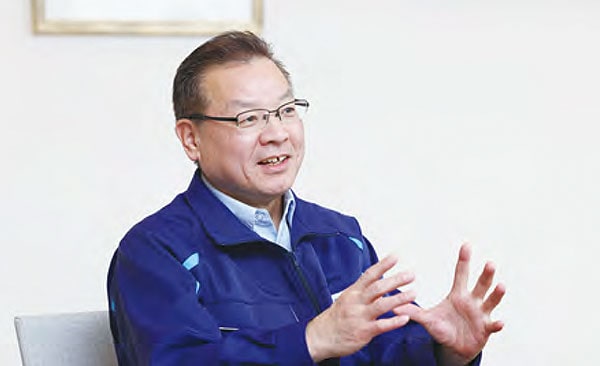
Okamoto
Although systems for an employee-friendly workplace, such as employee benefits, are in place, the use of these systems in the workplace is not sufficient. We have also established our vision for 2035 so that factory employees can use these systems in the same way as head office employees.
Kohara
Previously this was an initiative left up to each factory, but now as it is positioned as a top-down priority issue, we expect to see an acceleration of the initiative in the future. As President Yamamoto and other officers inspected each manufacturing site and listened sincerely to the voices of on-site workers, the importance of the project has been widely recognized.
Also, since the project was launched, multiple working teams have started to work on each issue. As measures to address immediate issues, we are already working to improve the work environment by revising the factory operation calendar to make it easier for workers to take time off, reducing on-site workload, and upgrading welfare facilities.
Kohara
As we were working with this project, it became clear that there were many issues for which the responsibility was unclear and no department in charge was defined. The situation was not so simple and the issues could not be solved by the joint effort of the head office and the factory alone; it requires involving management and divisions other than those involved in the project, and tackling issues that have not been addressed before.
Okamoto
Even though they are all tire factories, each factory has a different history and are also different in scale. As for the Izumiotsu Factory, our site is not particularly large, so we have to work to improve quality and productivity, as well as to make the factory employeefriendly with limited facilities and manpower.
Okuma
The Nagoya Factory has significant constraints on the equipment layout at the manufacturing site, and we have a problem of not being able to automate tasks that are physically demanding, such as transportation. Also, due to the nature of the region, there are many factories of major manufacturers nearby, which intensified competition to secure human resources.
Kohara
As for the Miyazaki Factory, we have managed to hire the number of workers we need through our hard work in recruiting, but we are aware that the number of job applicants is decreasing year by year. A decline in the population of surrounding areas is inevitable in the future, so we must start preparing for the future now.
Even just looking at the circumstances of the three factories, it is clear that each factory faces different challenges. In this regard, we must reflect on the fact that investment in human capital in factories has not necessarily been given high priority. We need a management vision for how to manage domestic production. The solution to these issues ultimately depends on how management thinks about them.
At the same time, it is important for us factory workers to take pride in our work and to feel fulfilled. In addition to moving forward with the project’s measures, we are also considering ways to evaluate the return on investment, such as employee satisfaction.
Okamoto
It is essential to share the belief that each individual’s work is valuable, and in order to achieve this, I believe that management and other leaders of the organization need to communicate the significance of manufacturing.
Kohara
I think that public relations within the Company is also important. At the Miyazaki Factory, we communicate information to coworkers, for example, providing explanations of the project’s outline on a large monitor installed in the factory cafeteria. I hope this will give them a sense of anticipation for the next improvement.
Okuma
I want employees to take ownership of the various measures.
That’s why it’s important how these measures are communicated. For example, improving the work environment for women is often viewed as a topic that has nothing to do with men. However, changing it to create a senior people-friendly workplace will attract attention from everyone regardless of gender.
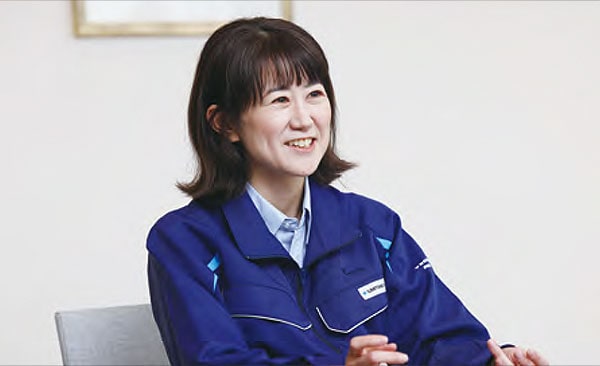
Kohara
“A factory where people can work with confidence and enthusiasm, and feel pride and joy in manufacturing” which was put up as our “vision” for 2035 was decided upon after much discussions among all project members. The project is promoted through a two-pillar approach: with measures that involve backcasting from the Ideal State where we want to be in 2035, and with measures that involve building up solutions for current issues in order to reach that Ideal State.
Through this project, each factory and the head office are working more closely together than ever before, and exchanging information more frequently. As an example, between factories and the production planning division at head office, discussions are ongoing to revise rules to create personnel plans so that it will be easier for employees to take paid leave and secure time for training. Also, many measures have been achieved through the efforts of the head office team, including expanding the budget for improving the work environment.
Okamoto
I am pleased that this project has given us more opportunities to present the urgent opinions of those at manufacturing sites to executives in the organization. For example, for the measures against heat in processes where temperatures exceed 40°C in the summer, a budget has been allocated for 2025 after one in 2024, making it possible to invest in workplace improvements.
Okuma
In general, the facilities at domestic tire factories are aging, and updating them is a major issue. On the other hand, even though overseas factories are relatively new, they will face the problem of aging in about 10 years or so. There are also bases where the declining birthrate and aging population are becoming a social issue, like in Japan. With such problems in mind, we believe it is important to first achieve results through projects at our domestic factories that will help us realize our vision. We will then be able to apply the results to our global bases in the future.
Okamoto
In terms of facilities, converting to an In-House New Factory concept is also a major issue. It is not easy to renew existing facilities while keeping them in operation, so we need to think about how to make effective use of the available space.
Kohara
It is difficult to pursue further improvement of production efficiency, labor savings, and automation while existing facilities are still in operation. However, precisely because it is difficult, it makes the challenge worthwhile, and I believe the challenge will provide a good opportunity for innovation at manufacturing sites. Our corporate culture is open and we are encouraged to try anything, and when we decide to take on a project like this, the management team is sincere when listening to our opinions. I hope that future generations will understand this corporate culture and play an active part, with pride in manufacturing and motivation for challenges.
Okamoto
Personally, I am always grateful to my seniors for helping me grow into a full-fledged professional. That’s why I want to return the favor. I want to provide proper guidance to young people and nurture as many workers as possible to lead the Future Factory.
Okuma
Since joining the Company, I have devoted myself to my work hoping that I will make cool tires. Now, I strongly hope to create a cool factory to produce cool tires. And I want to pursue my dream of making my factory the number one factory and the Company the number one tire manufacturer in Japan. All project members will work together to promote this project so that in 10 years’ time we can proudly say, “Our current quantum leap began with our project in 2025.”